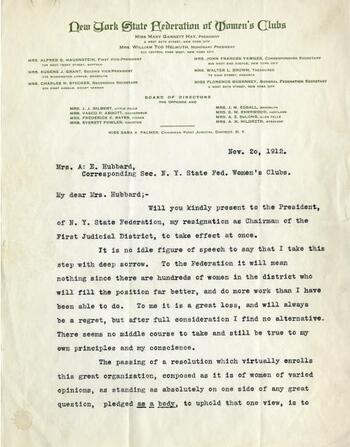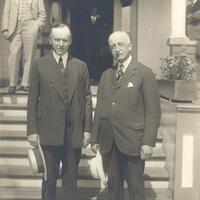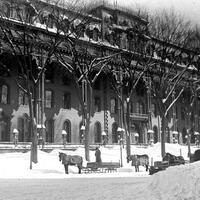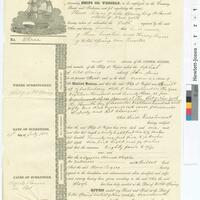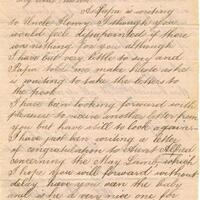The New York State Federation of Women’s Clubs was established in 1894. As outlined in the certificate of incorporation, the objective of the organization was to, “bring into relationship of mutual helpfulness the various clubs of women throughout the state and to make combined action possible when deemed expedient. (Subgroup III: 1:1:2).” The favorable response to the mission of the Club spurned a rapid growth in membership, by the second annual convention in 1896, 186 clubs within the state were represented.
Education, industrial conditions, forestry, welfare work, prison reform, philanthropy, household economics and club ethics were major initiatives of the Club in the first decades of the 20th Century. By the start of World War I the Club had expanded to 461 clubs and 300,000 federated women.
A growing response to the suffrage question was evidenced in the committee structure of the Federation during the presidency of Miss Mary Garrett Hay, 1910-1912. The establishment of the Suffrage and the Anti-Suffrage Committees exemplify the differing views of the role of women by women during the culturally shifting era of World War I (Subgroup I: 8:1:1-2). A report of the Bureau of Reciprocity and Information states, “The communications regarding this subject of Suffrage have been most explicit and the expressed desires for material on both sides of this questions have been so broad, it proves that club life creates a well-balanced, self-reliant woman (Subgroup I:9:1:1).”
After the suffrage amendment passed on November 6, 1917, Anna Brown, in her Presidential report made the following unifying message:
“For the first time in our history, we come together as citizens of this great Republic with all the privileges and responsibilities which that citizenship implies. Prior to November 6, there were suffragists and anti-suffragists among our members. The people of this state, by the action of a vast majority of its voters have declared that it is their will that the women of New York shall participate in the choice of public officials determined at the polls. It is not now a question as to whether we believe or do not believe in equal suffrage. It is no longer a matter for discussion, and it is for us to see that the trust imposed on us by the Constitution of the State shall be intelligently, unselfishly and loyally discharged (Subgroup VII:1:1:5)”
